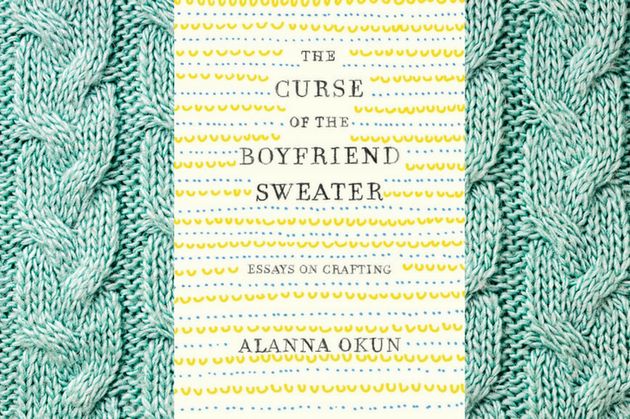
To be human, it seems, is to occasionally hear the disheartening drumbeat of self-criticism, the voice in one’s head that wonders whether you are the worst or if you should have said that thing or if you’d have been better off spending the whole day in bed. Less universal, I’d wager, is the idea to tack down these swirling self-saboteurs with a needle and thread.
In her new essay collection The Curse of the Boyfriend Sweater, author and crafter Alanna Okun describes the day she decided to treat swirling, unwelcome thoughts like “DON’T FEEL THAT” and “YOU ARE NOT ENOUGH” as any other quote she wanted to memorialize on an embroidery hoop.
“Each took about an hour to complete, which was exactly enough time to get so thoroughly sick of whatever was written in front of me that it had to shrink, had to be stripped of its context,” she writes, acknowledging that the practice ended up being less a magic bullet than a useful salve. “If I’d discovered that an hour of embroidery could fix the insidious ways we dismantle ourselves, this would be a very different type of book, and I would have a lot more money and a nicer apartment,” she later quips.
It’s a necessary caveat, because so much of mental health is not about finding the cure-all, but instead the practical task that feels manageable in the moment: journaling, meditation and, as Okun discovered, crafting.
“I liked taking this amorphous, menacing collection of voices that thrived in the darkest part of my brain and forcing them into the open,” Okun writes in her essay. “There, they shriveled.” The revelation is a valuable reminder that so-called frivolous pursuits — hobbies, crafts, anything done for oneself — are important, and even necessary.
If I were a librarian or bookseller, I’d have a hard time deciding where to shelve The Curse of the Boyfriend Sweater — should it sit with the other memoirs, or does it belong near the how-to manuals of models sporting jaunty knit berets? That the narrative is a bit of both — for those who craft, but also for those who go through life and feel deeply and hope they are not alone — is part of what makes it an enjoyable, accessible look at the role crafts can play in a life.
Crafters can likely identify the metaphors available in their hobby: There are generally small-scale problems to confront. Stitches are dropped; straight lines turn crooked. There’s inevitably a gap between what we think the thing should look like and the finished result. We can use it to remind ourselves of our ability to be patient, to create, to problem-solve — all in the name of the creation that turns up in our hands at the end, lovable in its own way, weird and imperfect and the only one in the world.
Creating something can be a tangible way to care for yourself, be it by providing literal warmth or by bringing, like Okun, ephemeral fears down to size. U.K.-based initiative Knit for Peace recently released findings from a review of previous studies on knitting’s physical and emotional benefits. It found a pattern of benefits: lower blood pressure, a distraction from chronic pain, a sense of well-being and community. A quick online search reveals other accounts of the practice’s ability to soothe and calm, forcing one’s attention only on the problem at hand. It’s easy to see why this semi-anachronistic activity, deliberately slowed down from the pace of life modern existence typically demands, is an appealing form of self-care.
Okun handles this idea well throughout her collection, acknowledging moments of deep significance in her crafting life without veering into treacly or overwrought territory. The book’s 27 chapters vary in introspection and length, cleverly bookended with two short essays titled “Casting On” and “Casting Off.” Some of the entries are quick, fun lists (“Things I’ve Used Knitting Needles for Besides Knitting”) and others are more straightforward, but still diary-esque walk-throughs for would-be crafters (“Tools of the Trade,” in which she makes a great case for not spending over $100 on interchangeable needle points).
The author shows a clear familiarity with the topic from her years making objects, starting when she watched and learned knitting from her grandmother as a child through the present, where Okun is now a begrudging member of the millennial crafting contingent. (Although, she couches the term for this generation in “as many ironic tildes and asterisks and quotation marks as you can fit into your field of vision.”) Her hobbies, she explains through her essays, have taken her through deep personal loss and relationships, both their woozy, hopeful beginnings and their difficult ends. It’s also given her a way to connect with others, either via a wistful missed connection with a fellow knitter on the subway, or on the vast internet of fellow makers who understand both the meaning of k2tog and the thrill of stocking up on soft Merino wool.
In the book’s titular essay, Okun tackles the lore that gifting a significant other a handmade sweater will ultimately lead to that relationship’s demise. Surprisingly, it’s not the boyfriends nor the knitted objects that feel like the essay’s heart, but the author’s ability to pinpoint why these people and moments are worth mentioning, why an item spun out of thin air can carry more weight than not: “a handmade object can almost serve like a walkie-talkie,” she explains, “a piece of string between two cups that the maker can whisper through: ‘I was here. I matter.’”
Moments like these are a continual highlight of the essays, which tend to focus on the years after high school and into one’s 20s, the chronically stress-inducing decade of uncertain futures and sure-seeming things falling out from under your feet. In looking back, the author teases out the joys and stresses of figuring out her path and place in life (figuratively and literally). Like a skilled knitter can turn some lifeless balls of yarn into a cabled pullover, so can Okun spin seemingly mundane aspects of life into moving vignettes.
In another essay, Okun describes the summer before she began college, when she decided to forgo her typical camp counselor job for a part-time gig she had yet to land. She thought that an environment stripped of the comforts of familiarity would prepare her for a new life.
“But then there was no new situation, nothing except group interviews and my parents’ couch and the looming fear that whatever was coming was going to be much bigger and more jagged than what I was leaving behind,” she writes, echoing the feelings of many an incoming freshman used to being defined by their grades and extracurriculars, and suddenly cut free from obligation. Later, she adds, “It was the first time, I guess, that I had nothing concrete to hold on to, to point at and prove I was doing okay.”
It’s this feeling that brings her back to knitting. Her products are imperfect at first — a cast-like pair of too-big socks and a dress with a drooping skirt — but a reminder, she says, “of how far I’ve come and how far I have left to go.”
The author’s willingness to share the less-cozy parts of her life makes the message — that crafts can be a friendly, nonjudgemental companion through the bumpier parts, presenting a surmountable, small obstacle to contrast many insurmountable ones — more of an achievable prospect.
